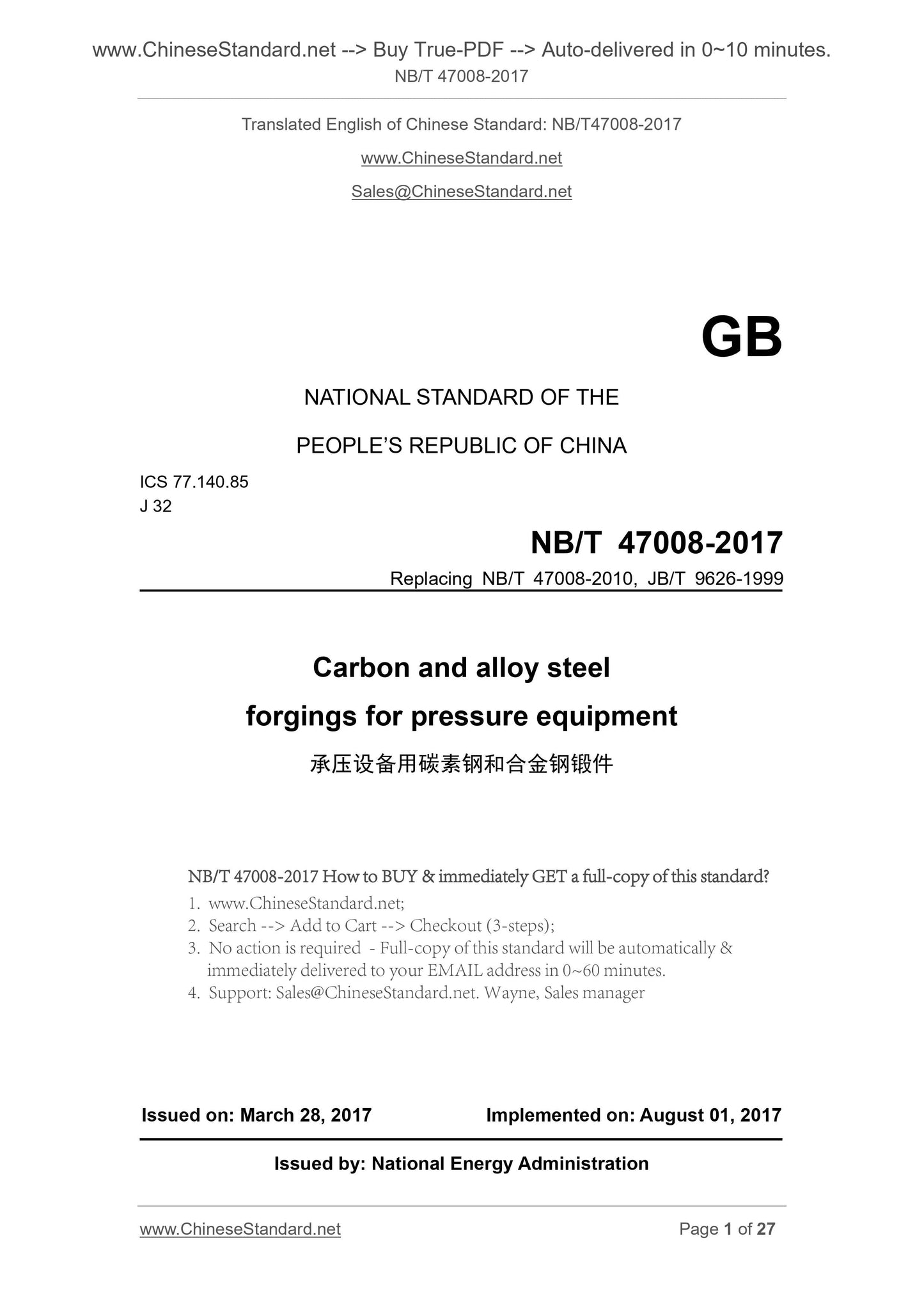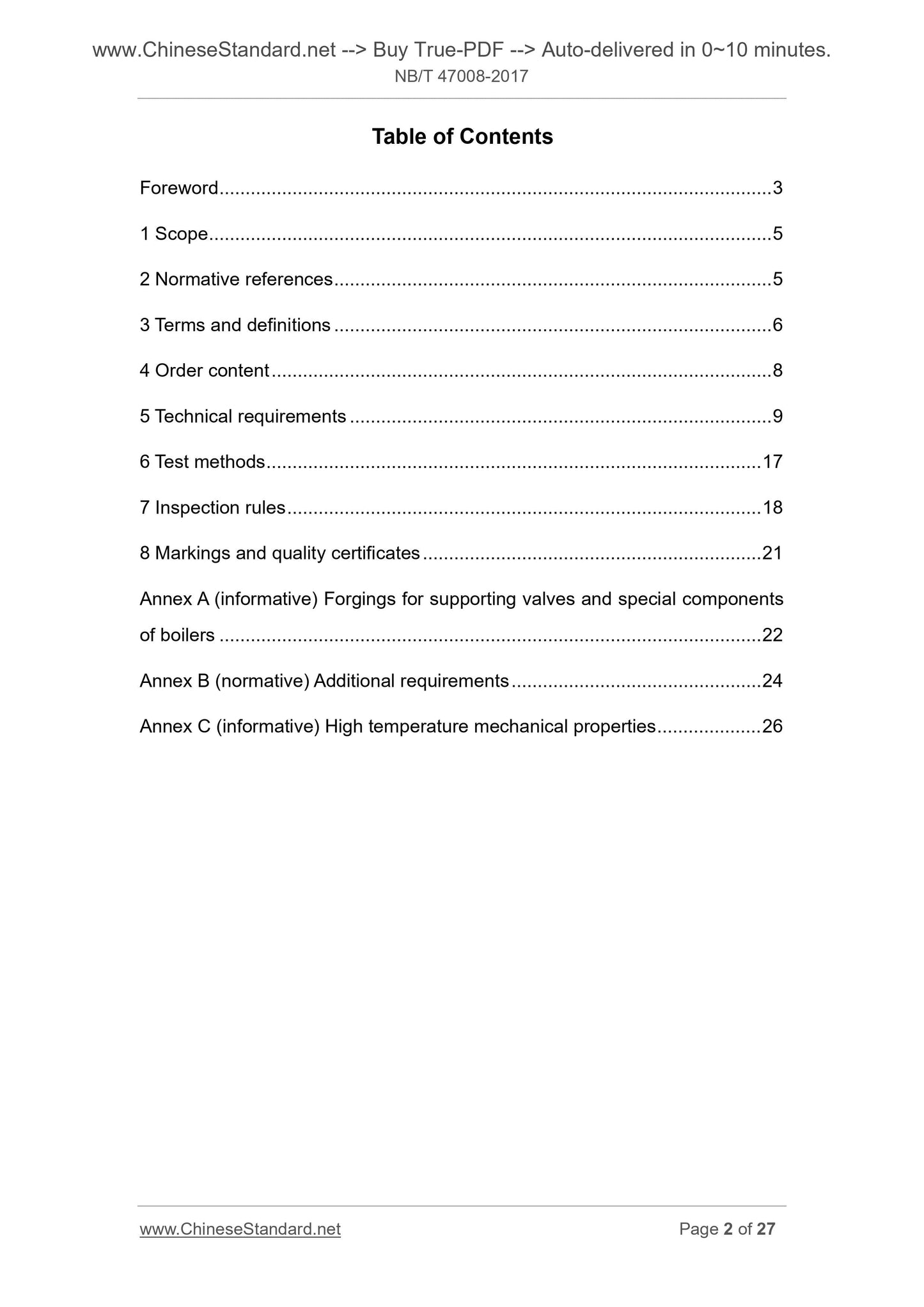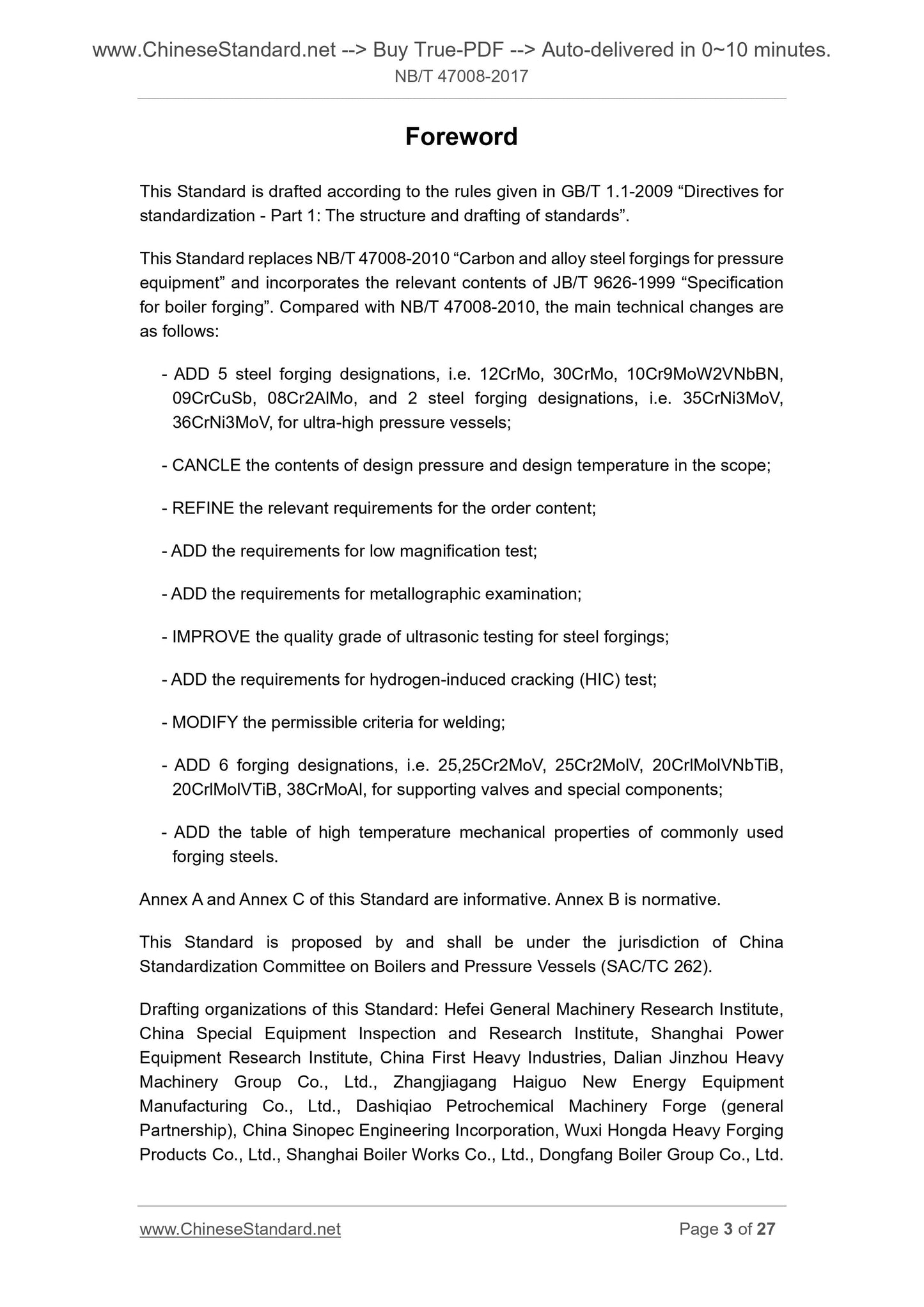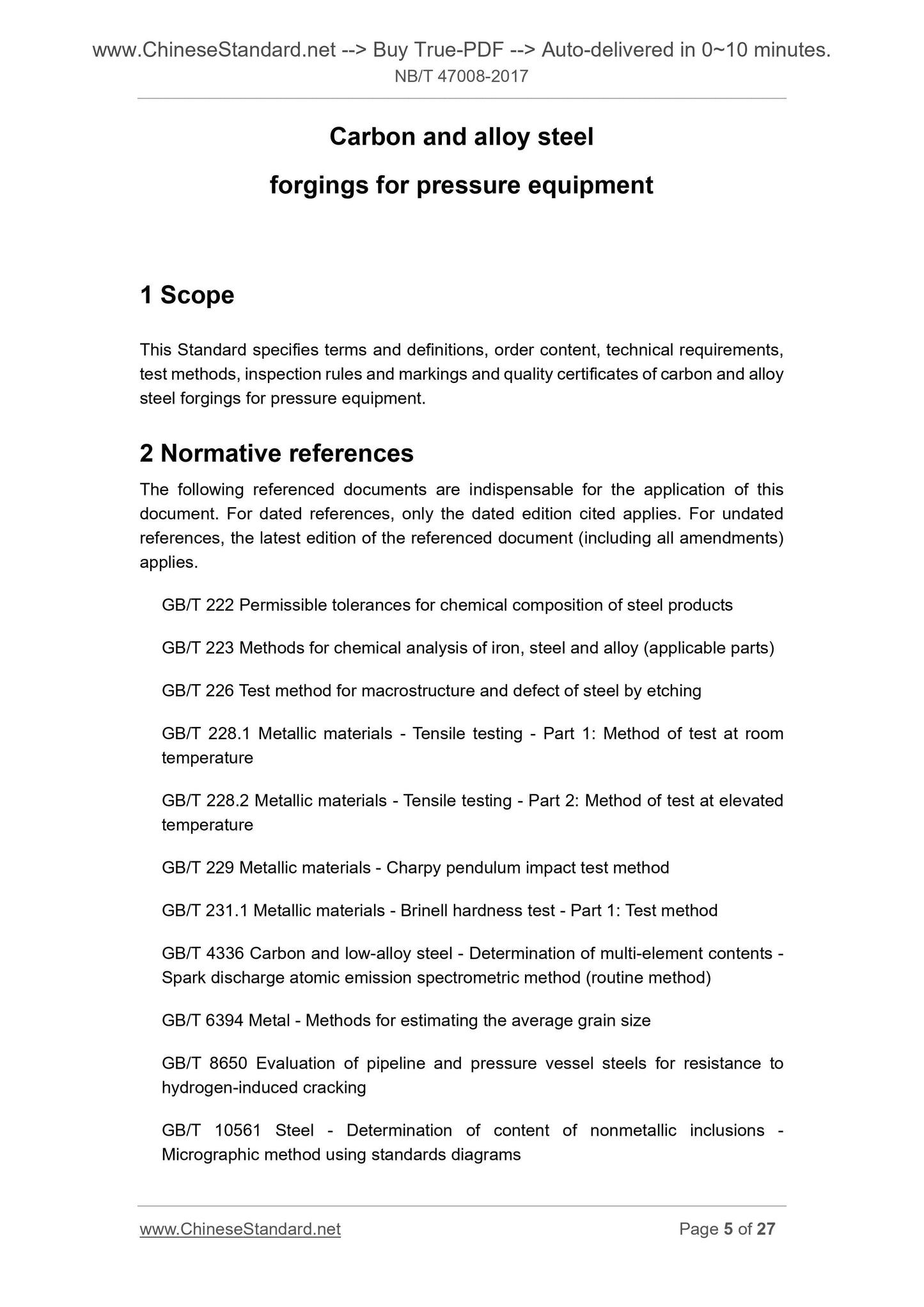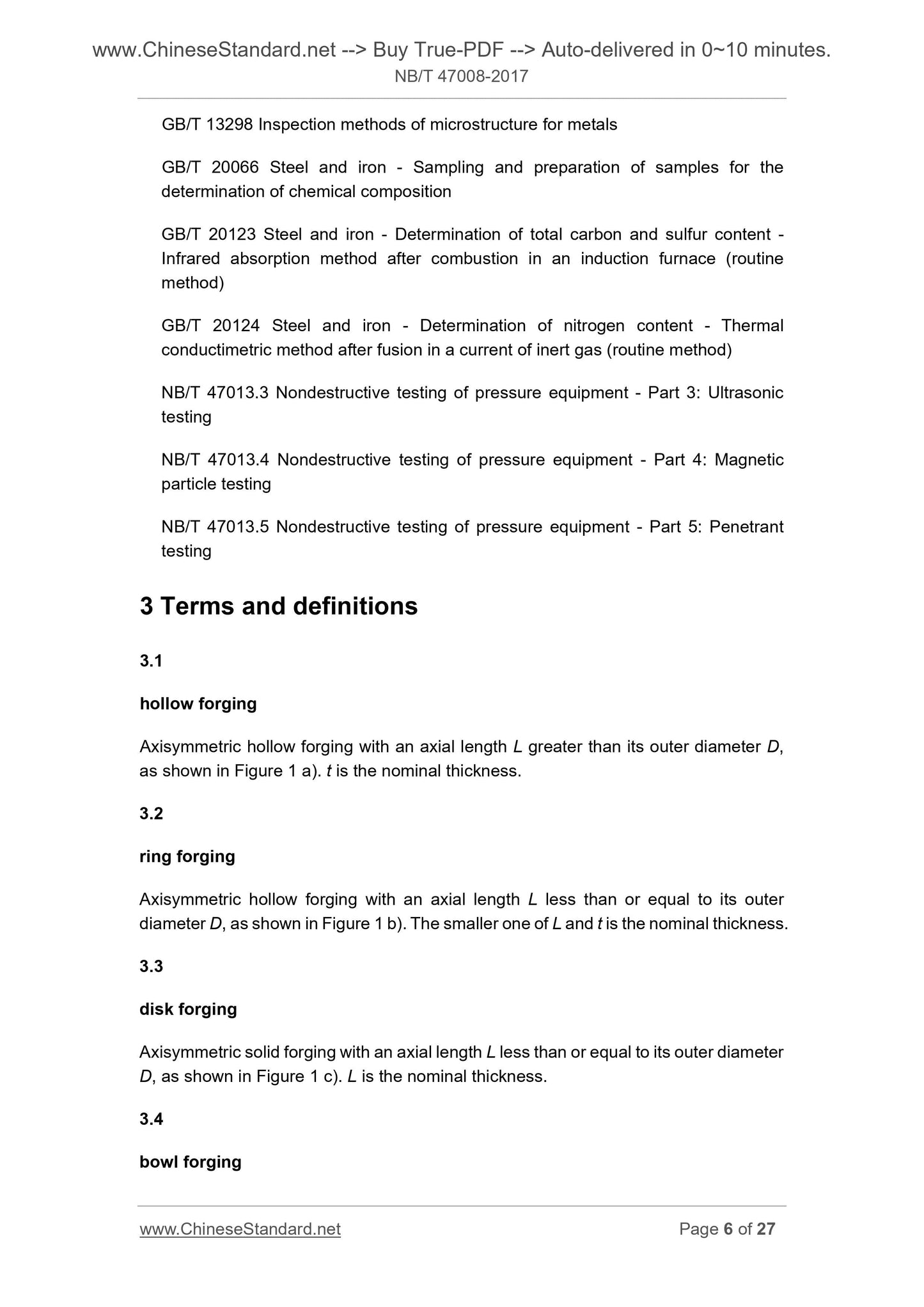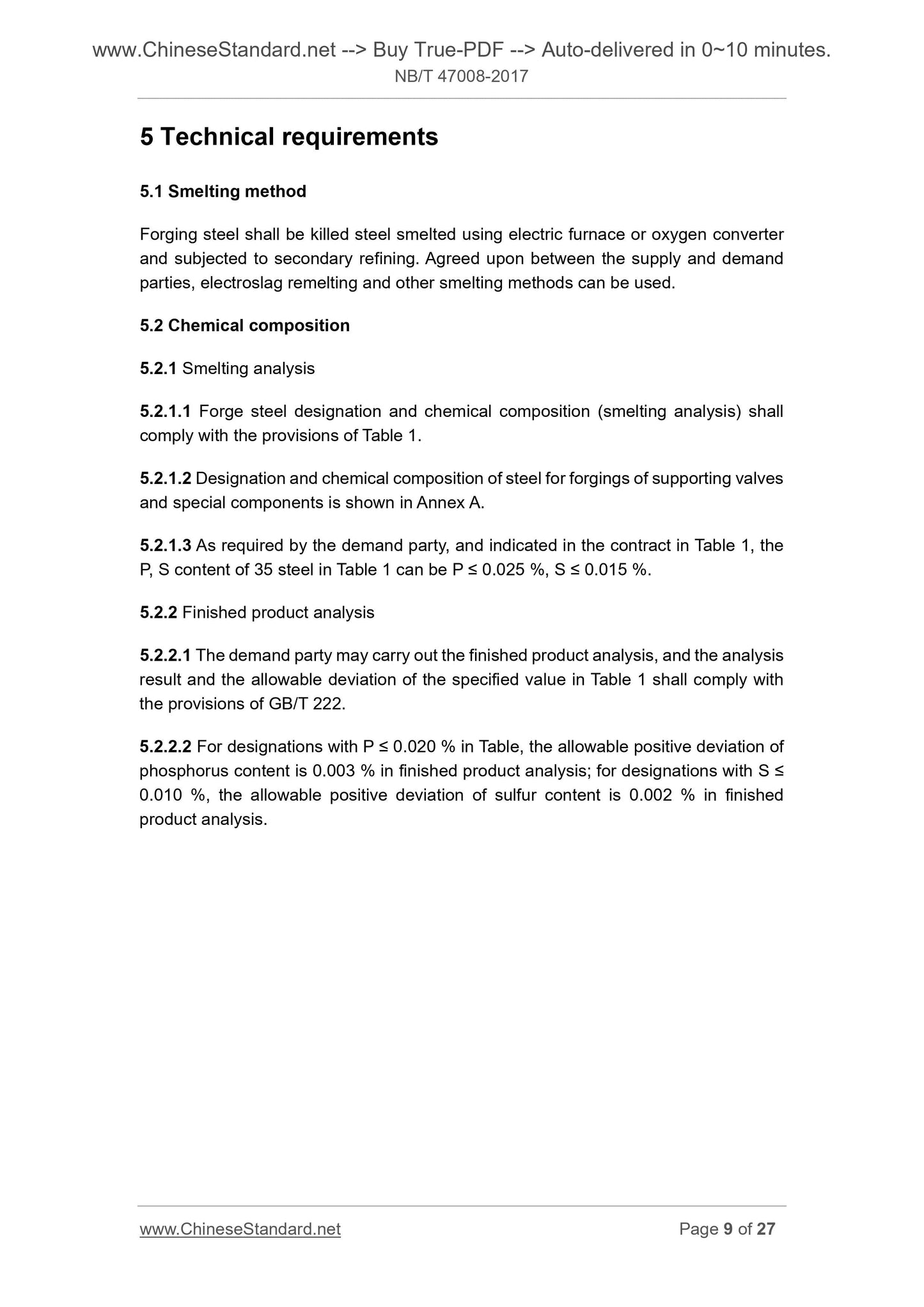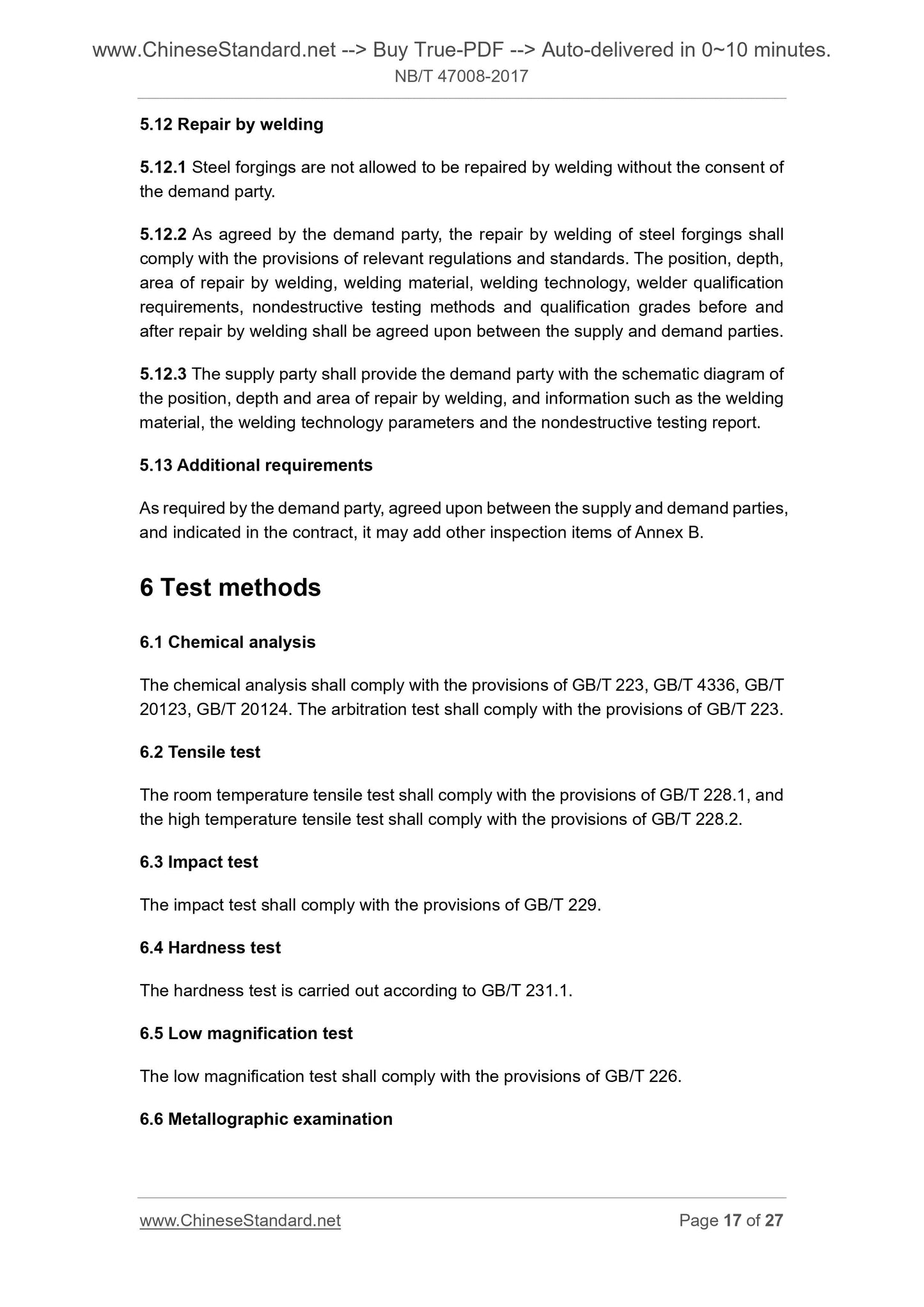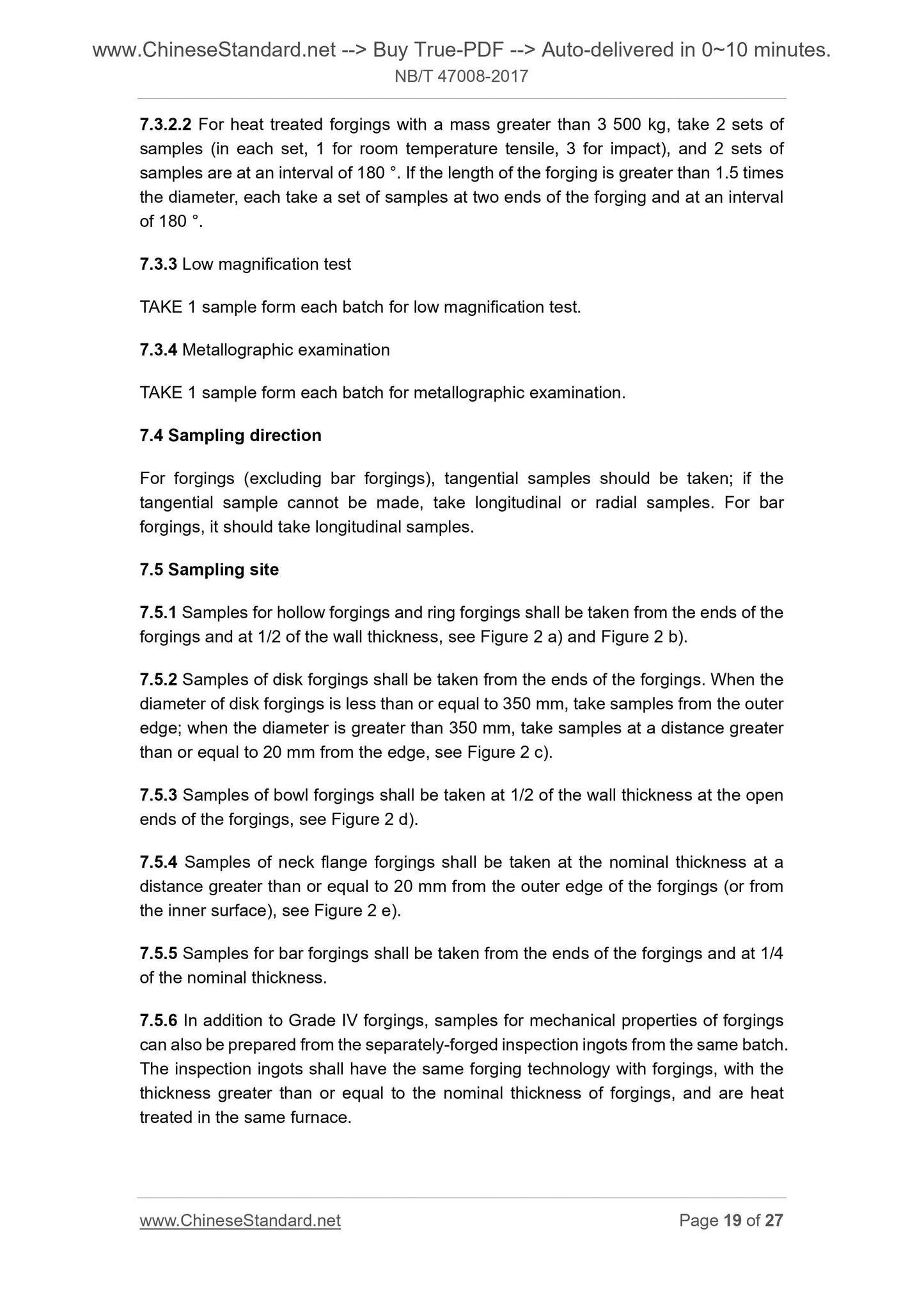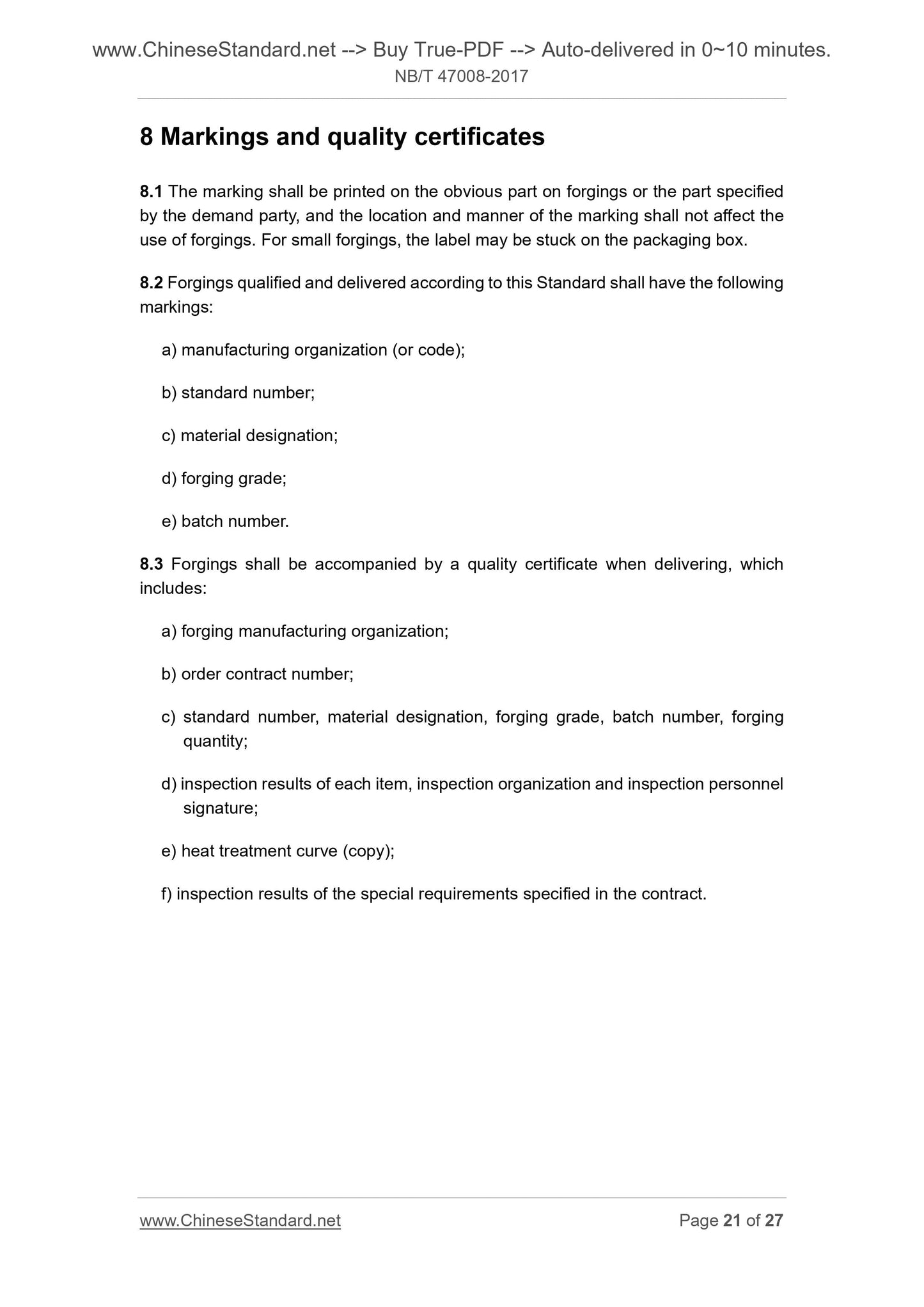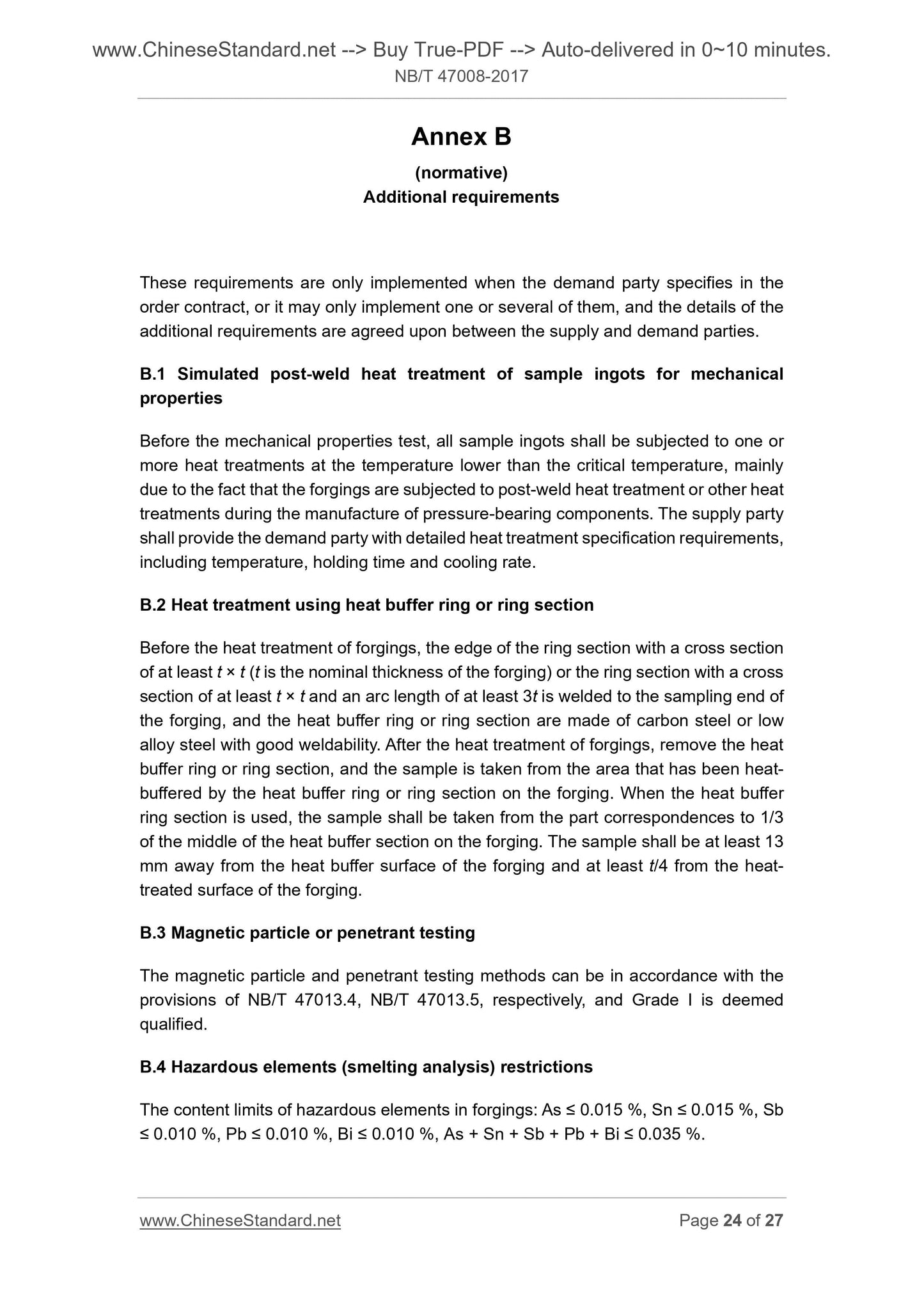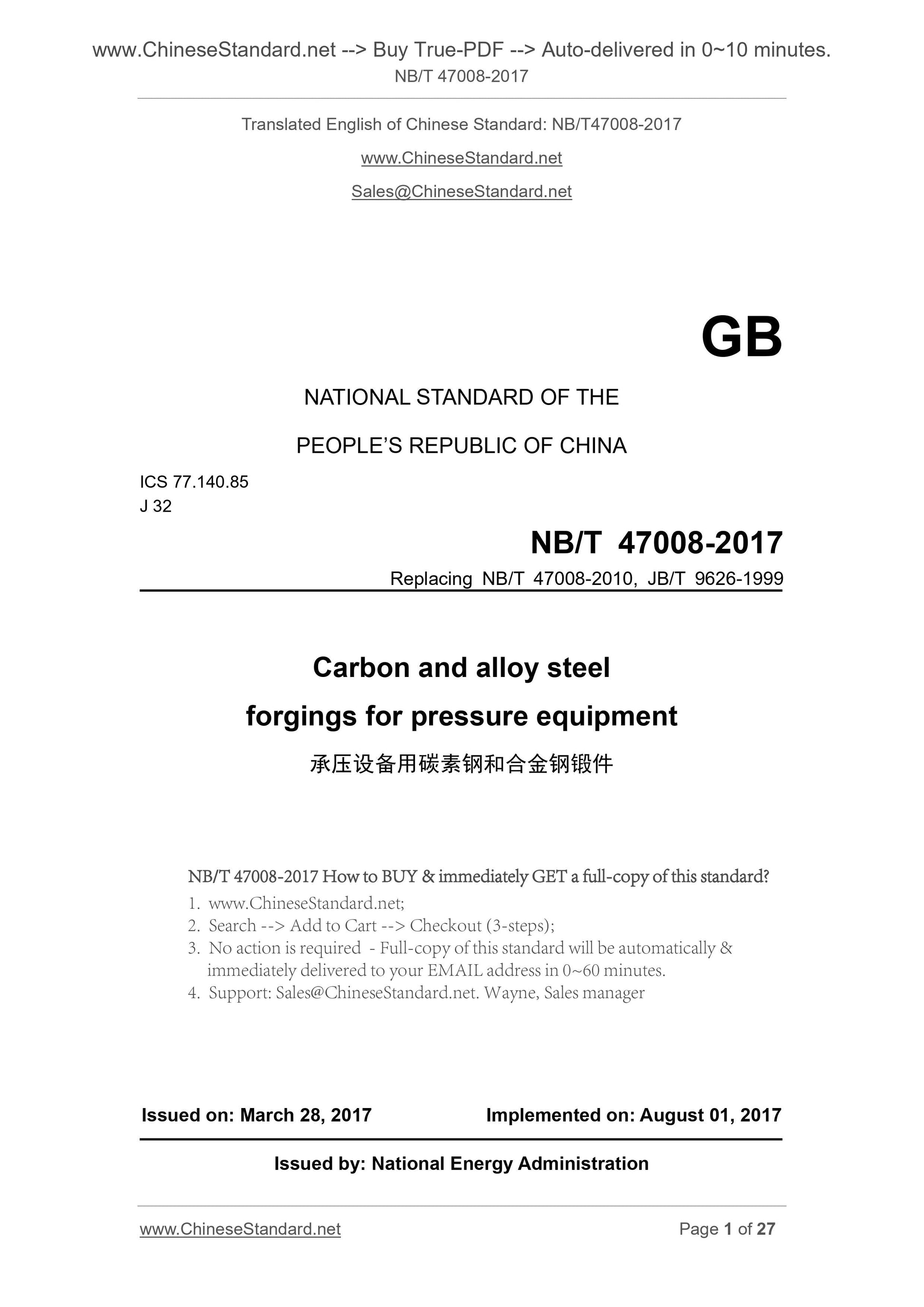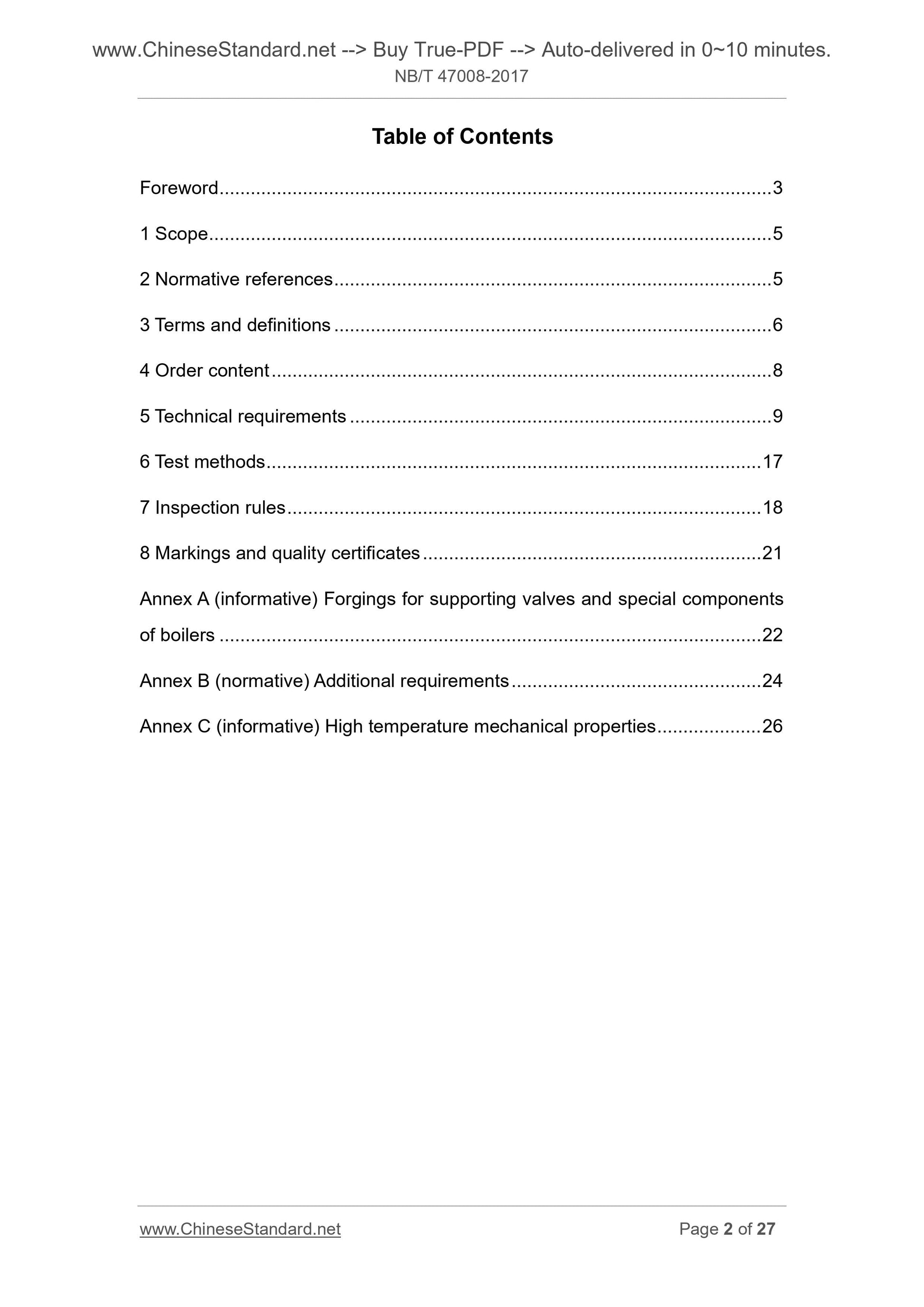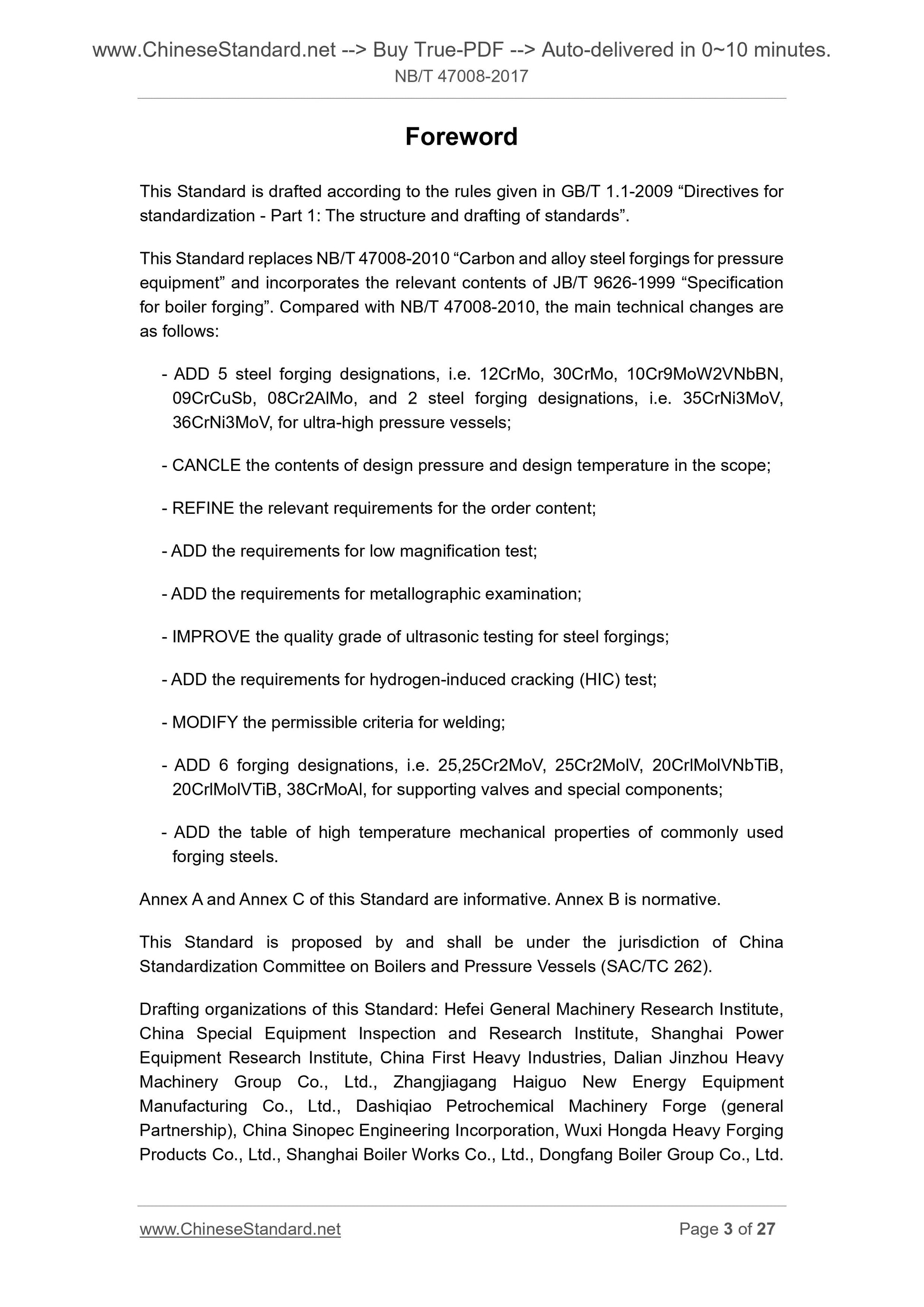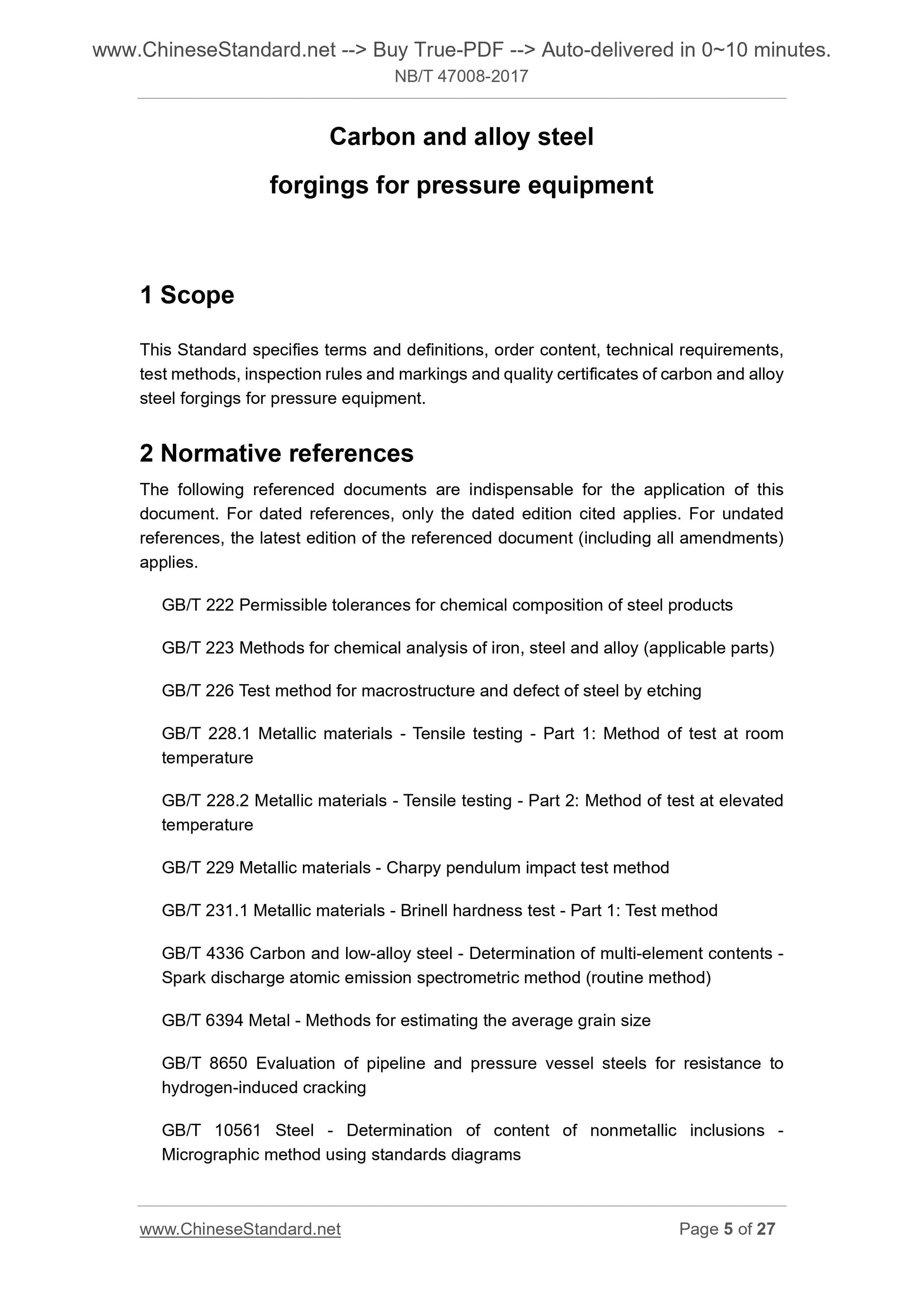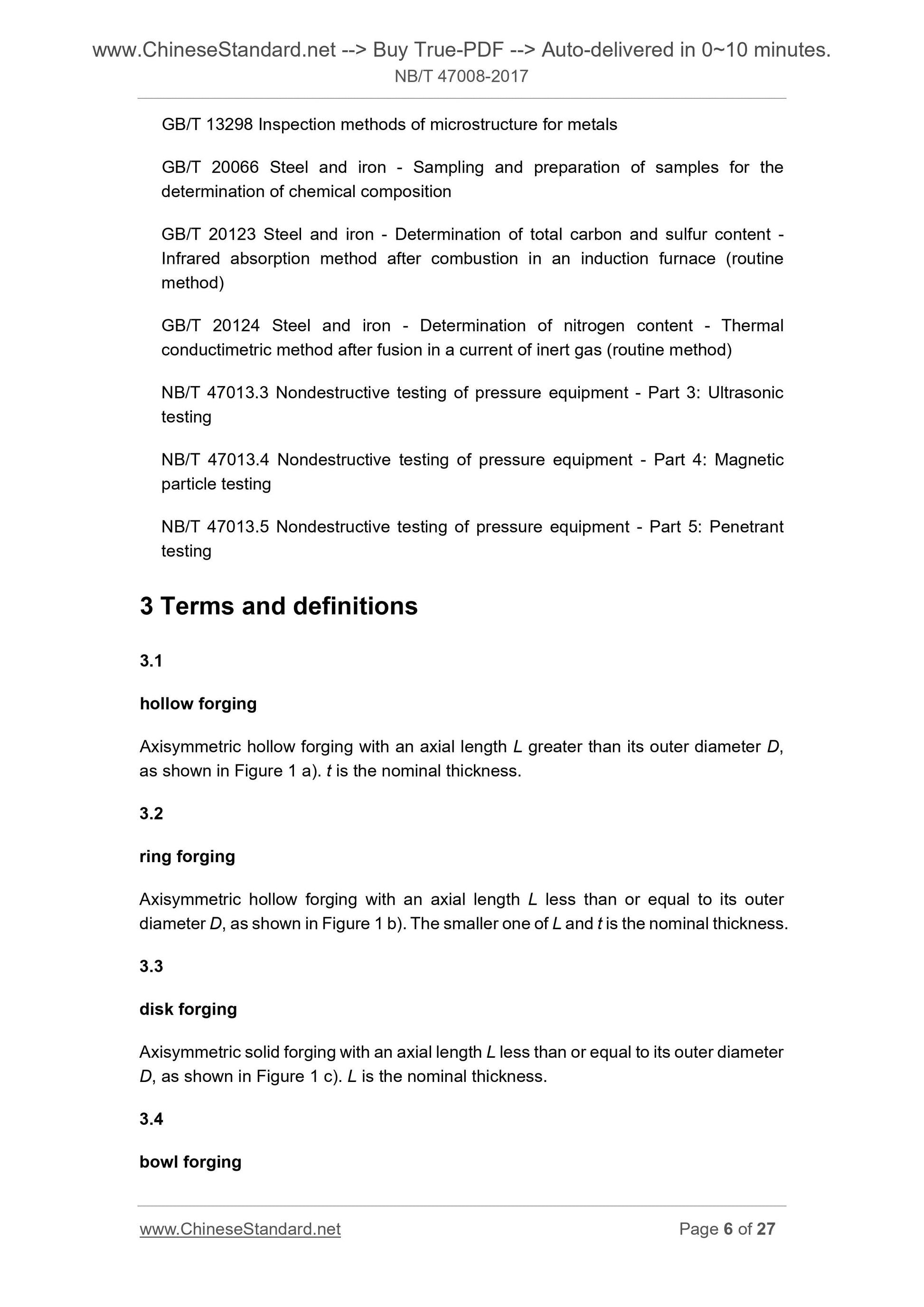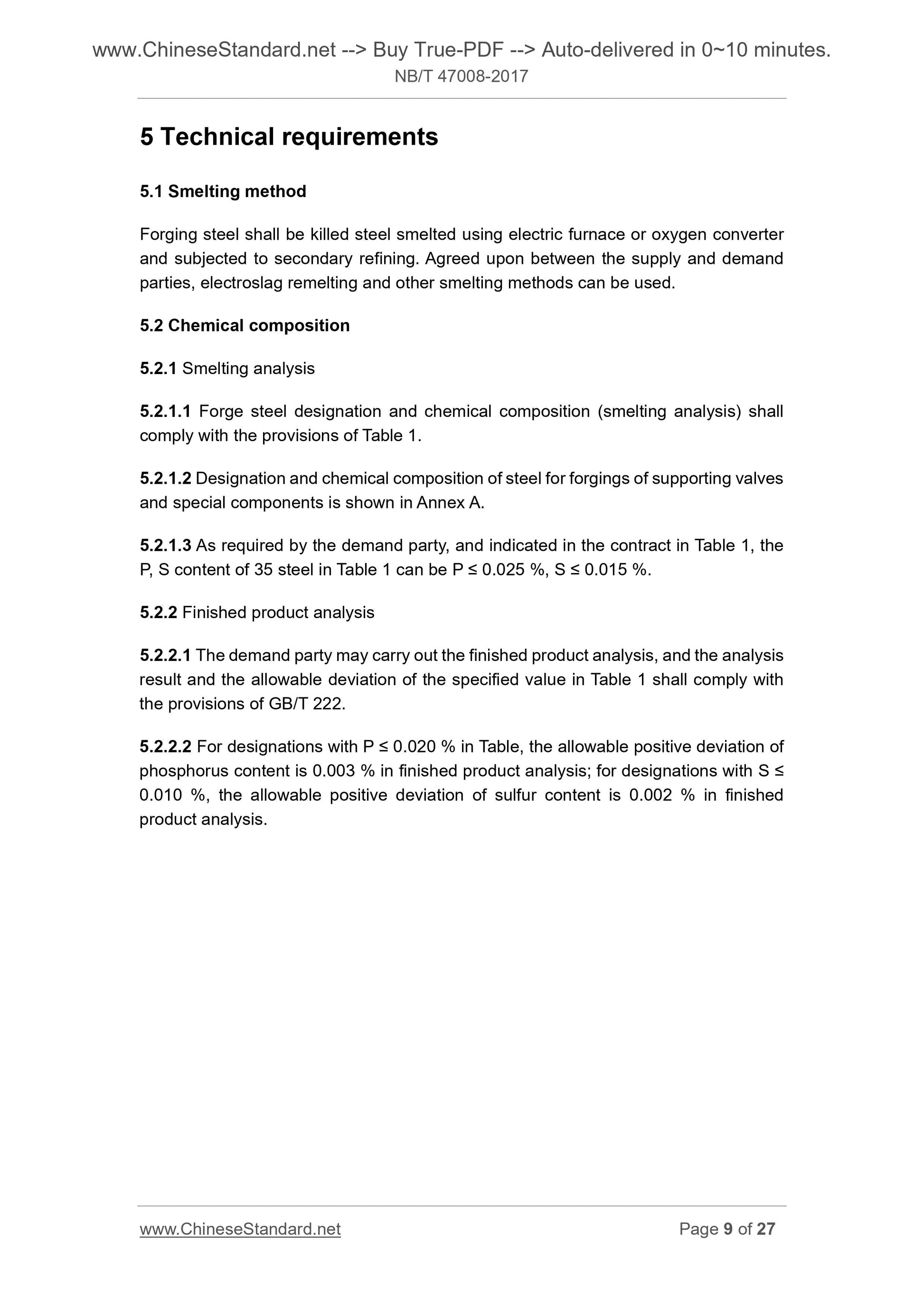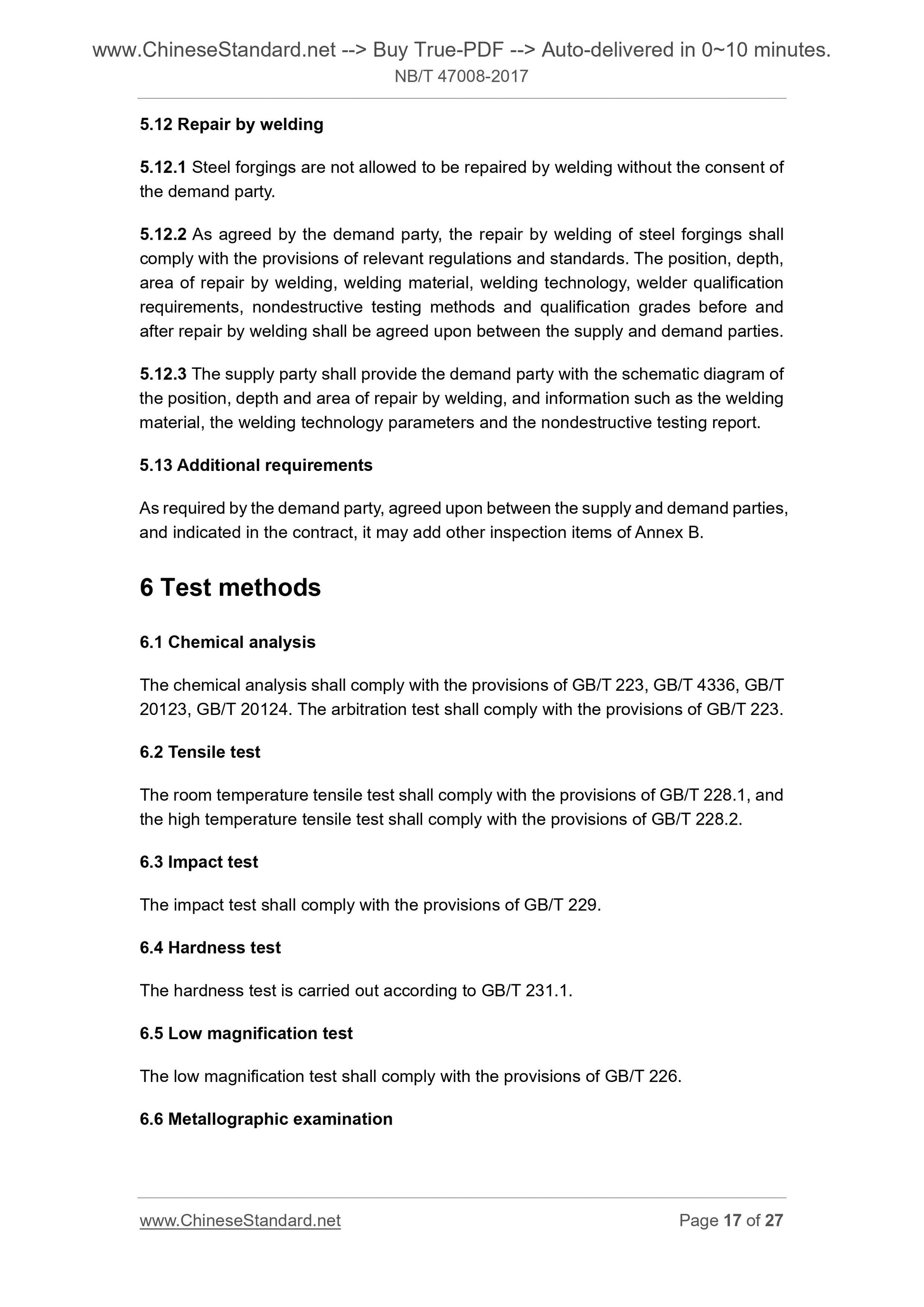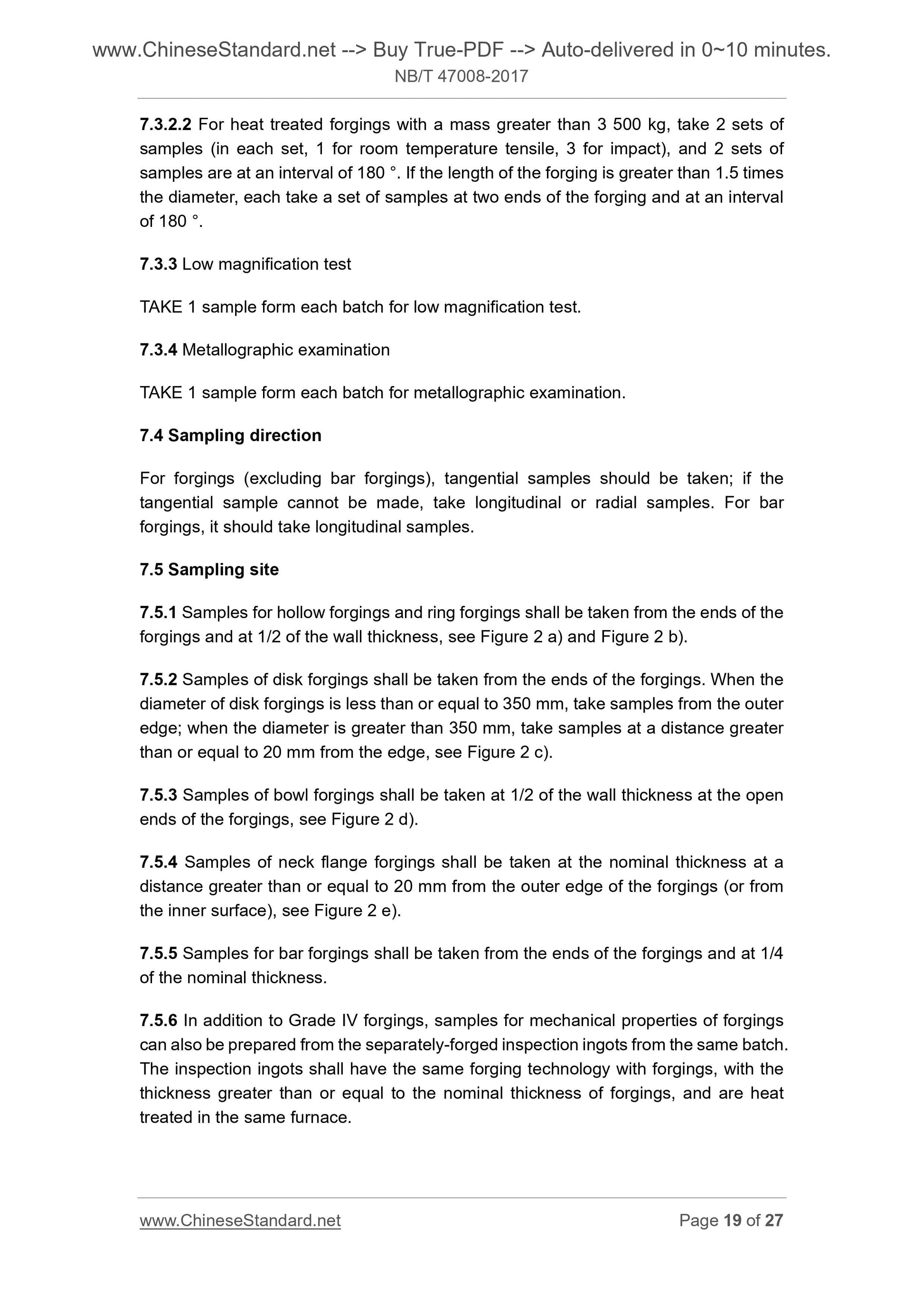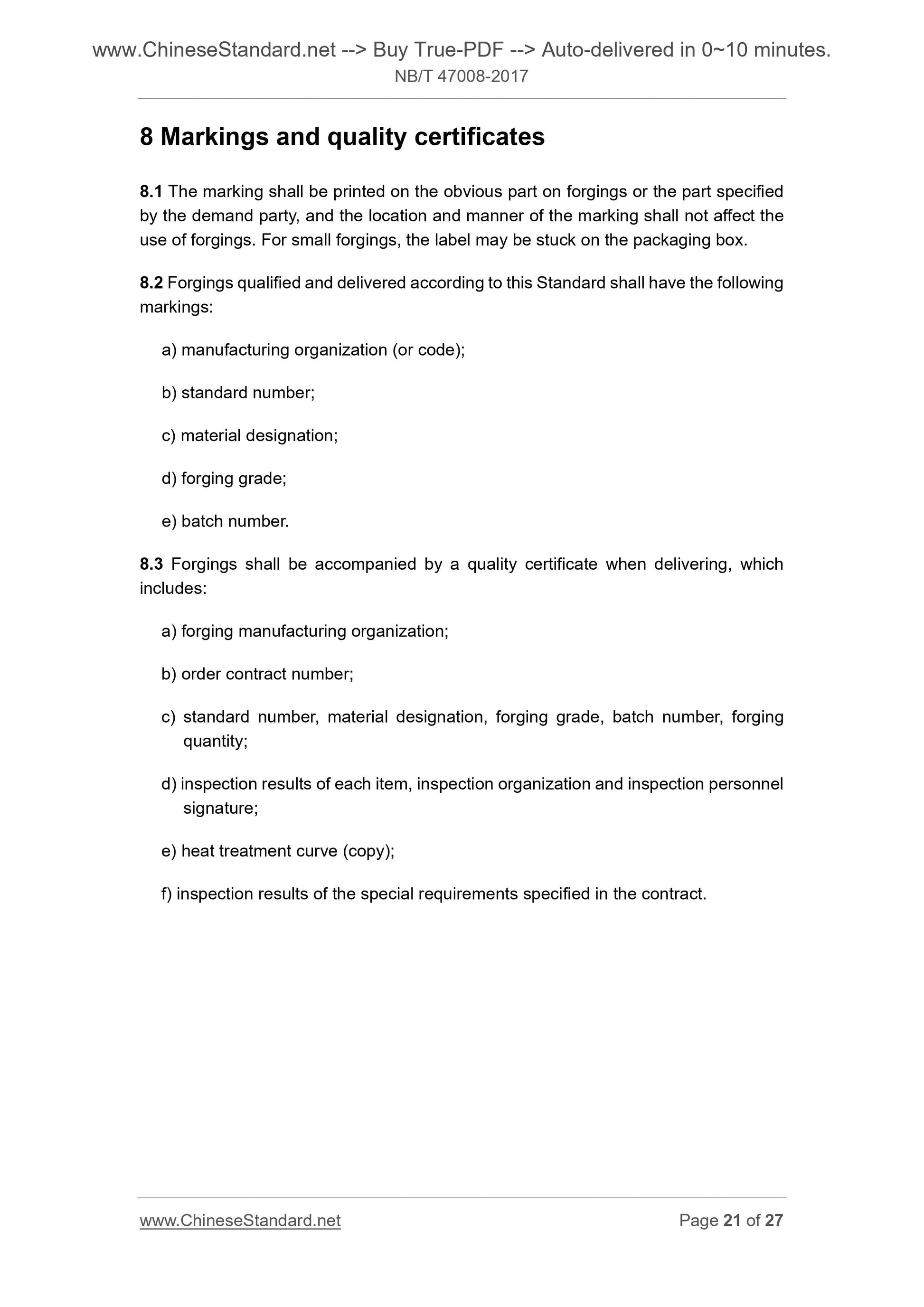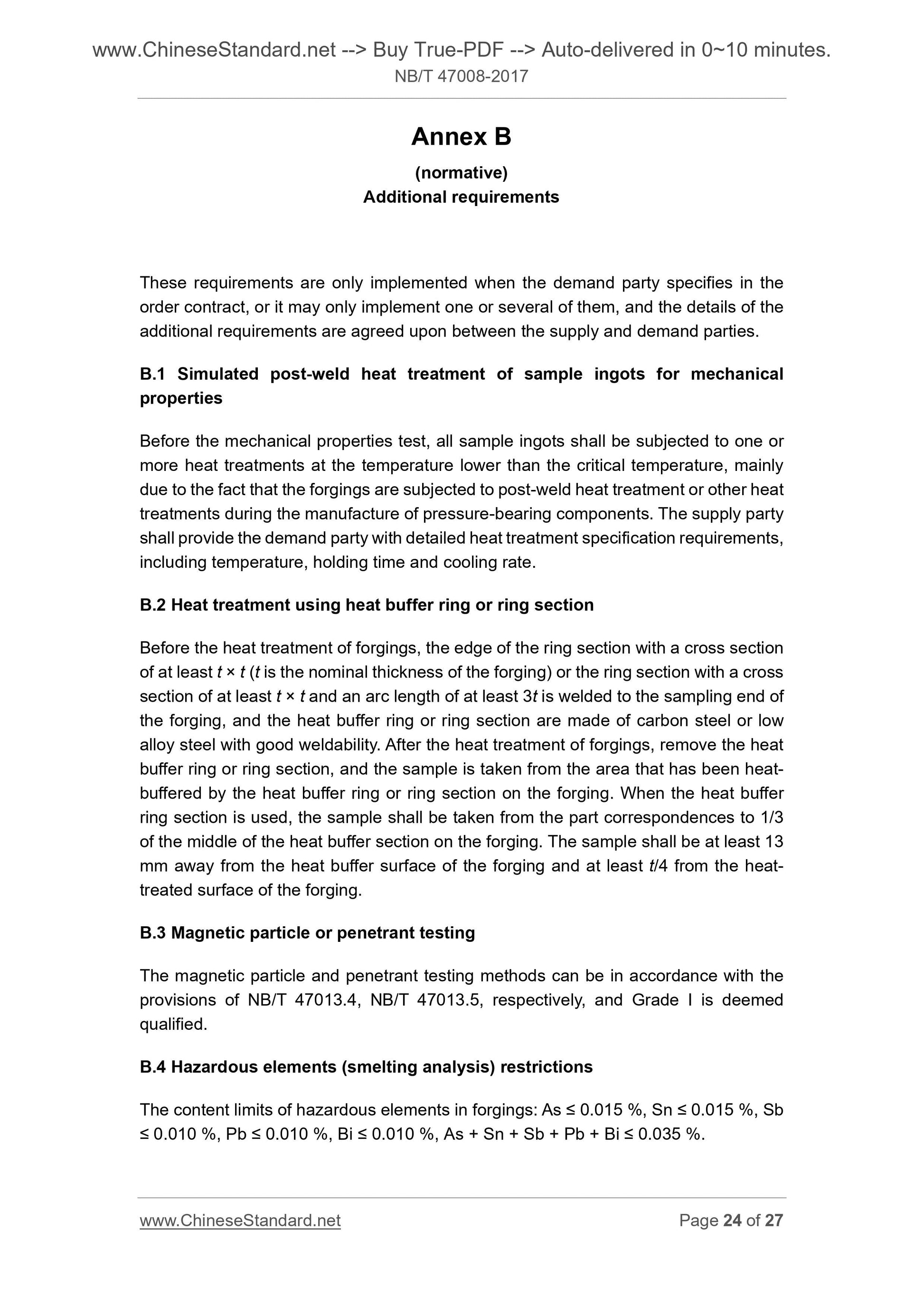1
/
of
10
PayPal, credit cards. Download editable-PDF and invoice in 1 second!
NB/T 47008-2017 English PDF (NBT47008-2017)
NB/T 47008-2017 English PDF (NBT47008-2017)
Regular price
$125.00 USD
Regular price
Sale price
$125.00 USD
Unit price
/
per
Shipping calculated at checkout.
Couldn't load pickup availability
Delivery: 3 seconds. Download true-PDF + Invoice.
Get QUOTATION in 1-minute: Click NB/T 47008-2017
Historical versions: NB/T 47008-2017
Preview True-PDF (Reload/Scroll if blank)
NB/T 47008-2017: Carbon and alloy steel forgings for pressure equipment
NB/T 47008-2017
GB
NATIONAL STANDARD OF THE
PEOPLE’S REPUBLIC OF CHINA
ICS 77.140.85
J 32
Replacing NB/T 47008-2010, JB/T 9626-1999
Carbon and alloy steel
forgings for pressure equipment
ISSUED ON. MARCH 28, 2017
IMPLEMENTED ON. AUGUST 01, 2017
Issued by. National Energy Administration
3. No action is required - Full-copy of this standard will be automatically and
immediately delivered to your EMAIL address in 0~60 minutes.
Table of Contents
Foreword ... 3
1 Scope ... 5
2 Normative references ... 5
3 Terms and definitions ... 6
4 Order content ... 8
5 Technical requirements ... 9
6 Test methods ... 17
7 Inspection rules ... 18
8 Markings and quality certificates ... 21
Annex A (informative) Forgings for supporting valves and special components
of boilers ... 22
Annex B (normative) Additional requirements ... 24
Annex C (informative) High temperature mechanical properties ... 26
Foreword
This Standard is drafted according to the rules given in GB/T 1.1-2009 “Directives for
standardization - Part 1. The structure and drafting of standards”.
This Standard replaces NB/T 47008-2010 “Carbon and alloy steel forgings for pressure
equipment” and incorporates the relevant contents of JB/T 9626-1999 “Specification
for boiler forging”. Compared with NB/T 47008-2010, the main technical changes are
as follows.
- ADD 5 steel forging designations, i.e. 12CrMo, 30CrMo, 10Cr9MoW2VNbBN,
09CrCuSb, 08Cr2AlMo, and 2 steel forging designations, i.e. 35CrNi3MoV,
36CrNi3MoV, for ultra-high pressure vessels;
- CANCLE the contents of design pressure and design temperature in the scope;
- REFINE the relevant requirements for the order content;
- ADD the requirements for low magnification test;
- ADD the requirements for metallographic examination;
- IMPROVE the quality grade of ultrasonic testing for steel forgings;
- ADD the requirements for hydrogen-induced cracking (HIC) test;
- MODIFY the permissible criteria for welding;
- ADD 6 forging designations, i.e. 25,25Cr2MoV, 25Cr2MolV, 20CrlMolVNbTiB,
20CrlMolVTiB, 38CrMoAl, for supporting valves and special components;
- ADD the table of high temperature mechanical properties of commonly used
forging steels.
Annex A and Annex C of this Standard are informative. Annex B is normative.
This Standard is proposed by and shall be under the jurisdiction of China
Standardization Committee on Boilers and Pressure Vessels (SAC/TC 262).
Drafting organizations of this Standard. Hefei General Machinery Research Institute,
China Special Equipment Inspection and Research Institute, Shanghai Power
Equipment Research Institute, China First Heavy Industries, Dalian Jinzhou Heavy
Machinery Group Co., Ltd., Zhangjiagang Haiguo New Energy Equipment
Manufacturing Co., Ltd., Dashiqiao Petrochemical Machinery Forge (general
Partnership), China Sinopec Engineering Incorporation, Wuxi Hongda Heavy Forging
Products Co., Ltd., Shanghai Boiler Works Co., Ltd., Dongfang Boiler Group Co., Ltd.
Carbon and alloy steel
forgings for pressure equipment
1 Scope
This Standard specifies terms and definitions, order content, technical requirements,
test methods, inspection rules and markings and quality certificates of carbon and alloy
steel forgings for pressure equipment.
2 Normative references
The following referenced documents are indispensable for the application of this
document. For dated references, only the dated edition cited applies. For undated
references, the latest edition of the referenced document (including all amendments)
applies.
GB/T 222 Permissible tolerances for chemical composition of steel products
GB/T 223 Methods for chemical analysis of iron, steel and alloy (applicable parts)
GB/T 226 Test method for macrostructure and defect of steel by etching
GB/T 228.1 Metallic materials - Tensile testing - Part 1. Method of test at room
temperature
GB/T 228.2 Metallic materials - Tensile testing - Part 2. Method of test at elevated
temperature
GB/T 229 Metallic materials - Charpy pendulum impact test method
GB/T 231.1 Metallic materials - Brinell hardness test - Part 1. Test method
GB/T 4336 Carbon and low-alloy steel - Determination of multi-element contents -
Spark discharge atomic emission spectrometric method (routine method)
GB/T 6394 Metal - Methods for estimating the average grain size
GB/T 8650 Evaluation of pipeline and pressure vessel steels for resistance to
hydrogen-induced cracking
GB/T 10561 Steel - Determination of content of nonmetallic inclusions -
Micrographic method using standards diagrams
GB/T 13298 Inspection methods of microstructure for metals
GB/T 20066 Steel and iron - Sampling and preparation of samples for the
determination of chemical composition
GB/T 20123 Steel and iron - Determination of total carbon and sulfur content -
Infrared absorption method after combustion in an induction furnace (routine
method)
GB/T 20124 Steel and iron - Determination of nitrogen content - Thermal
conductimetric method after fusion in a current of inert gas (routine method)
NB/T 47013.3 Nondestructive testing of pressure equipment - Part 3. Ultrasonic
testing
NB/T 47013.4 Nondestructive testing of pressure equipment - Part 4. Magnetic
particle testing
NB/T 47013.5 Nondestructive testing of pressure equipment - Part 5. Penetrant
testing
3 Terms and definitions
3.1
hollow forging
Axisymmetric hollow forging with an axial length L greater than its outer diameter D,
as shown in Figure 1 a). t is the nominal thickness.
3.2
ring forging
Axisymmetric hollow forging with an axial length L less than or equal to its outer
diameter D, as shown in Figure 1 b). The smaller one of L and t is the nominal thickness.
3.3
disk forging
Axisymmetric solid forging with an axial length L less than or equal to its outer diameter
D, as shown in Figure 1 c). L is the nominal thickness.
3.4
bowl forging
5 Technical requirements
5.1 Smelting method
Forging steel shall be killed steel smelted using electric furnace or oxygen converter
and subjected to secondary refining. Agreed upon between the supply and demand
parties, electroslag remelting and other smelting methods can be used.
5.2 Chemical composition
5.2.1 Smelting analysis
5.2.1.1 Forge steel designation and chemical composition (smelting analysis) shall
comply with the provisions of Table 1.
5.2.1.2 Designation and chemical composition of steel for forgings of supporting valves
and special components is shown in Annex A.
5.2.1.3 As required by the demand party, and indicated in the contract in Table 1, the
P, S content of 35 steel in Table 1 can be P ≤ 0.025 %, S ≤ 0.015 %.
5.2.2 Finished product analysis
5.2.2.1 The demand party may carry out the finished product analysis, and the analysis
result and the allowable deviation of the specified value in Table 1 shall comply with
the provisions of GB/T 222.
5.2.2.2 For designations with P ≤ 0.020 % in Table, the allowable positive deviation of
phosphorus content is 0.003 % in finished product analysis; for designations with S ≤
0.010 %, the allowable positive deviation of sulfur content is 0.002 % in finished
product analysis.
5.12 Repair by welding
5.12.1 Steel forgings are not allowed to be repaired by welding without the consent of
the demand party.
5.12.2 As agreed by the demand party, the repair by welding of steel forgings shall
comply with the provisions of relevant regulat...
Get QUOTATION in 1-minute: Click NB/T 47008-2017
Historical versions: NB/T 47008-2017
Preview True-PDF (Reload/Scroll if blank)
NB/T 47008-2017: Carbon and alloy steel forgings for pressure equipment
NB/T 47008-2017
GB
NATIONAL STANDARD OF THE
PEOPLE’S REPUBLIC OF CHINA
ICS 77.140.85
J 32
Replacing NB/T 47008-2010, JB/T 9626-1999
Carbon and alloy steel
forgings for pressure equipment
ISSUED ON. MARCH 28, 2017
IMPLEMENTED ON. AUGUST 01, 2017
Issued by. National Energy Administration
3. No action is required - Full-copy of this standard will be automatically and
immediately delivered to your EMAIL address in 0~60 minutes.
Table of Contents
Foreword ... 3
1 Scope ... 5
2 Normative references ... 5
3 Terms and definitions ... 6
4 Order content ... 8
5 Technical requirements ... 9
6 Test methods ... 17
7 Inspection rules ... 18
8 Markings and quality certificates ... 21
Annex A (informative) Forgings for supporting valves and special components
of boilers ... 22
Annex B (normative) Additional requirements ... 24
Annex C (informative) High temperature mechanical properties ... 26
Foreword
This Standard is drafted according to the rules given in GB/T 1.1-2009 “Directives for
standardization - Part 1. The structure and drafting of standards”.
This Standard replaces NB/T 47008-2010 “Carbon and alloy steel forgings for pressure
equipment” and incorporates the relevant contents of JB/T 9626-1999 “Specification
for boiler forging”. Compared with NB/T 47008-2010, the main technical changes are
as follows.
- ADD 5 steel forging designations, i.e. 12CrMo, 30CrMo, 10Cr9MoW2VNbBN,
09CrCuSb, 08Cr2AlMo, and 2 steel forging designations, i.e. 35CrNi3MoV,
36CrNi3MoV, for ultra-high pressure vessels;
- CANCLE the contents of design pressure and design temperature in the scope;
- REFINE the relevant requirements for the order content;
- ADD the requirements for low magnification test;
- ADD the requirements for metallographic examination;
- IMPROVE the quality grade of ultrasonic testing for steel forgings;
- ADD the requirements for hydrogen-induced cracking (HIC) test;
- MODIFY the permissible criteria for welding;
- ADD 6 forging designations, i.e. 25,25Cr2MoV, 25Cr2MolV, 20CrlMolVNbTiB,
20CrlMolVTiB, 38CrMoAl, for supporting valves and special components;
- ADD the table of high temperature mechanical properties of commonly used
forging steels.
Annex A and Annex C of this Standard are informative. Annex B is normative.
This Standard is proposed by and shall be under the jurisdiction of China
Standardization Committee on Boilers and Pressure Vessels (SAC/TC 262).
Drafting organizations of this Standard. Hefei General Machinery Research Institute,
China Special Equipment Inspection and Research Institute, Shanghai Power
Equipment Research Institute, China First Heavy Industries, Dalian Jinzhou Heavy
Machinery Group Co., Ltd., Zhangjiagang Haiguo New Energy Equipment
Manufacturing Co., Ltd., Dashiqiao Petrochemical Machinery Forge (general
Partnership), China Sinopec Engineering Incorporation, Wuxi Hongda Heavy Forging
Products Co., Ltd., Shanghai Boiler Works Co., Ltd., Dongfang Boiler Group Co., Ltd.
Carbon and alloy steel
forgings for pressure equipment
1 Scope
This Standard specifies terms and definitions, order content, technical requirements,
test methods, inspection rules and markings and quality certificates of carbon and alloy
steel forgings for pressure equipment.
2 Normative references
The following referenced documents are indispensable for the application of this
document. For dated references, only the dated edition cited applies. For undated
references, the latest edition of the referenced document (including all amendments)
applies.
GB/T 222 Permissible tolerances for chemical composition of steel products
GB/T 223 Methods for chemical analysis of iron, steel and alloy (applicable parts)
GB/T 226 Test method for macrostructure and defect of steel by etching
GB/T 228.1 Metallic materials - Tensile testing - Part 1. Method of test at room
temperature
GB/T 228.2 Metallic materials - Tensile testing - Part 2. Method of test at elevated
temperature
GB/T 229 Metallic materials - Charpy pendulum impact test method
GB/T 231.1 Metallic materials - Brinell hardness test - Part 1. Test method
GB/T 4336 Carbon and low-alloy steel - Determination of multi-element contents -
Spark discharge atomic emission spectrometric method (routine method)
GB/T 6394 Metal - Methods for estimating the average grain size
GB/T 8650 Evaluation of pipeline and pressure vessel steels for resistance to
hydrogen-induced cracking
GB/T 10561 Steel - Determination of content of nonmetallic inclusions -
Micrographic method using standards diagrams
GB/T 13298 Inspection methods of microstructure for metals
GB/T 20066 Steel and iron - Sampling and preparation of samples for the
determination of chemical composition
GB/T 20123 Steel and iron - Determination of total carbon and sulfur content -
Infrared absorption method after combustion in an induction furnace (routine
method)
GB/T 20124 Steel and iron - Determination of nitrogen content - Thermal
conductimetric method after fusion in a current of inert gas (routine method)
NB/T 47013.3 Nondestructive testing of pressure equipment - Part 3. Ultrasonic
testing
NB/T 47013.4 Nondestructive testing of pressure equipment - Part 4. Magnetic
particle testing
NB/T 47013.5 Nondestructive testing of pressure equipment - Part 5. Penetrant
testing
3 Terms and definitions
3.1
hollow forging
Axisymmetric hollow forging with an axial length L greater than its outer diameter D,
as shown in Figure 1 a). t is the nominal thickness.
3.2
ring forging
Axisymmetric hollow forging with an axial length L less than or equal to its outer
diameter D, as shown in Figure 1 b). The smaller one of L and t is the nominal thickness.
3.3
disk forging
Axisymmetric solid forging with an axial length L less than or equal to its outer diameter
D, as shown in Figure 1 c). L is the nominal thickness.
3.4
bowl forging
5 Technical requirements
5.1 Smelting method
Forging steel shall be killed steel smelted using electric furnace or oxygen converter
and subjected to secondary refining. Agreed upon between the supply and demand
parties, electroslag remelting and other smelting methods can be used.
5.2 Chemical composition
5.2.1 Smelting analysis
5.2.1.1 Forge steel designation and chemical composition (smelting analysis) shall
comply with the provisions of Table 1.
5.2.1.2 Designation and chemical composition of steel for forgings of supporting valves
and special components is shown in Annex A.
5.2.1.3 As required by the demand party, and indicated in the contract in Table 1, the
P, S content of 35 steel in Table 1 can be P ≤ 0.025 %, S ≤ 0.015 %.
5.2.2 Finished product analysis
5.2.2.1 The demand party may carry out the finished product analysis, and the analysis
result and the allowable deviation of the specified value in Table 1 shall comply with
the provisions of GB/T 222.
5.2.2.2 For designations with P ≤ 0.020 % in Table, the allowable positive deviation of
phosphorus content is 0.003 % in finished product analysis; for designations with S ≤
0.010 %, the allowable positive deviation of sulfur content is 0.002 % in finished
product analysis.
5.12 Repair by welding
5.12.1 Steel forgings are not allowed to be repaired by welding without the consent of
the demand party.
5.12.2 As agreed by the demand party, the repair by welding of steel forgings shall
comply with the provisions of relevant regulat...
Share
